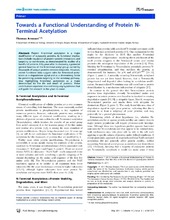| dc.contributor.author | Arnesen, Thomas | eng |
| dc.date.accessioned | 2012-02-20T11:15:16Z | |
| dc.date.available | 2012-02-20T11:15:16Z | |
| dc.date.issued | 2011-05-31 | eng |
| dc.Published | PLoS Biology 9(5): e1001074 | en |
| dc.identifier.issn | 1544-9173 | en_US |
| dc.identifier.uri | https://hdl.handle.net/1956/5621 | |
| dc.description.abstract | Protein N-terminal acetylation is a major modification of eukaryotic proteins. Its functional implications include regulation of protein–protein interactions and targeting to membranes, as demonstrated by studies of a handful of proteins. Fifty years after its discovery, a potential general function of the N-terminal acetyl group carried by thousands of unique proteins remains enigmatic. However, recent functional data suggest roles for N-terminal acetylation as a degradation signal and as a determining factor for preventing protein targeting to the secretory pathway, thus highlighting N-terminal acetylation as a major determinant for the life and death of proteins. These contributions represent new and intriguing hypotheses that will guide the research in the years to come. | en_US |
| dc.language.iso | eng | eng |
| dc.publisher | Public Library of Science | en_US |
| dc.rights | Attribution CC BY | eng |
| dc.rights.uri | http://creativecommons.org/licenses/by/2.5/ | eng |
| dc.title | Towards a Functional Understanding of Protein NTerminal Acetylation | en_US |
| dc.type | Peer reviewed | |
| dc.type | Journal article | |
| dc.description.version | publishedVersion | en_US |
| dc.rights.holder | Copyright 2011 Thomas Arnesen | en_US |
| dc.identifier.doi | https://doi.org/10.1371/journal.pbio.1001074 | |
| dc.subject.nsi | VDP::Mathematics and natural science: 400::Basic biosciences: 470 | en_US |

